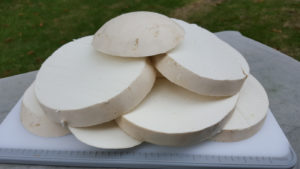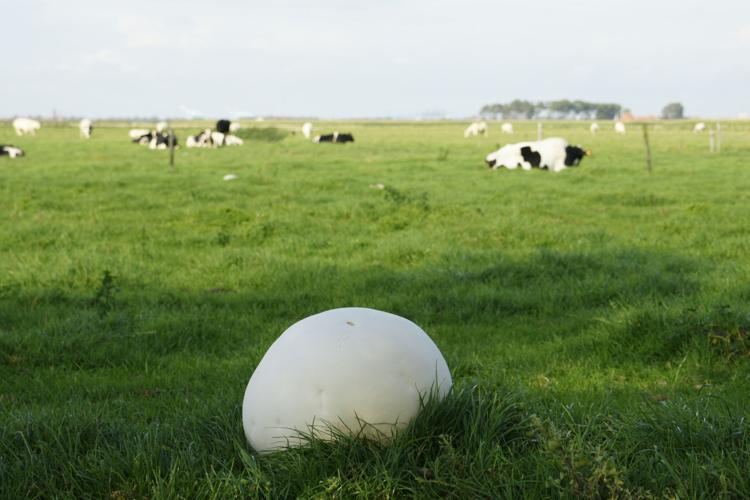As the common name of Giant Puffball suggests, the Calvatia gigantea can grow up to 80cm in diameter and weigh a few kilograms; although, specimens of 150 cm and nearly 23 kilograms have been reported. Calvatia gigantea are relatively common and easily identifiable due to their large, round, white, blob shape and from a distance may be mistaken for a football. The name Calvatia gigantea can be broken down into Calvatia – meaning a bald head or a skull and gigantea is due to its potential to become gigantic in size. Remarkably it can grow to its maximum size in only a week. The reference to a Puffball is due to the powdery mass of spores, reaching several trillion that are produced on the maturation of the fungus.
The Calvatia Gigantea was originally described by August Johann Georg Karl Batsch in 1786, and he named it Lycoperdon giganteum. It was re-named Calvatia Gigantea by Curtis Gates Lloyd in 1904. Langermannia gigantea is a synonym for Calvatia gigantea, and this is due to a taxonomic argument that requires adequate DNA analysis to settle the dispute, it does not appear that this will be any time soon and therefore, the names may be used interchangeably.
Prior to the use of matches, strips of Calvatia Gigantea would be used to carry fire between locations. In this regard, beekeepers would also burn the mushroom to calm the bees and avoid being stung; it was thought that the mushroom might act as a sedative although, this may be more related to the smoke causing the bees to be more subdued.

My name is Austin Collins.
I've dedicated my life to Mushrooms.
I believe Mushrooms are the best kept secret when it comes to health and well being.
For that reason, I would like to share a company with you that in my opinion makes the best mushroom products on the market.
The company is called Noomadic Herbals, my favorite supplement they make is called "Mushroom Total".
I take their products every day and they have helped me think better and have more energy. Give them a try.
-Austin
Calvatia Gigantea Identification and Description
Fruitbody: Large and shaped like an irregular globe or ball. White when immature, changing to yellow or olive-brown with maturity as the outer surface moves apart to reveal the brown spores. Soft velvety skin when young becoming papery with age. Frequently has a short cord attaching to point in the ground. Some areas of the mushroom may have fine scales. The basal area is not sterile, unlike many other puffballs.
Gills: No gills

Stem: Not present but can be attached to the ground by a cord; cord 6cm long & 2cm wide.
Smell: Mild and not unpleasant.
Taste: Mild or non-distinctive.
Spores: Largely spheroidal; smooth or with small warts and thick-walled. Created inside the fruiting body; several trillion spores. Released with age, rain, damage, or when blown across the ground like tumbleweed.
Spore color: Olive brown.
Edibility: Edible only when immature and prior to forming spores; flesh must be white. Peel away skin first.
Habitat: Saprobic; nutrient-rich areas including roadside verges; deciduous forests; woodland and edge of meadows; among nettles and scrubs and in drainage ditches. Grows in temperate climates in the northern and southern hemispheres. Protected in Poland; rare in Lithuania and in Norway, is a conservation concern.
Season: Grows through summer and fall.
Calvatia Gigantea Look-a-likes
Handkea utriformis is similar to Calvatia gigantea, although it is much smaller. Scleroderma citrinum, also known as the Earthball, is similar, but the fruiting body becomes purple-black with a white net-like appearance when young. It is important to note that Scleroderma citrinum is poisonous and should not be eaten.
Some immature and gilled mushrooms that are still within their veil can look like Calvatia gigantea. They can be distinguished by cutting the flesh open to identify gills, and the mushrooms should have a cap-shaped profile.
Calvatia Gigantea Benefits
Mushrooms have a history of being used in medicine for thousands of years, and Calvatia gigantea is no exception. Calvatia gigantea is a fleshy mushroom and is excellent when eaten young when the flesh is white and firm. Because it is a meaty mushroom so it can be sliced and eaten like steak or coated with breadcrumbs or batter and fried; it is also used in stews and casseroles. The Calvatia gigantea has been used for many years in traditional medicine to aid a sore throat, alleviate the symptoms of chronic coughing, and reduce inflammation and pain. There is very little scientific evidence in support of these medical conditions; however, this may not be due to the absence of these benefits, but rather the research not being performed.
The Calvatia gigantea is rich in polyunsaturated fatty acids (PUFAs), protein, and carbohydrates. Many argue that mushrooms are comparable in nutrition to some meat, eggs, and milk.
Anti-diabetic
A very recent study produced some promising data, indicating that the extract of Calvatia gigantea is able to reduce blood sugar levels, an important consideration for controlling blood sugar levels in diabetics [1]. Using a rat model and monitoring short term effects of 400mg/kg of Calvatia gigantea extract, a significant decrease in blood sugar levels was seen in the rats.
Anti-microbial
Staphylococcus aureus is the most dangerous of the Staphylococcus bacteria and can often cause skin infections and respiratory tract infections, including pneumonia. Staphylococcus aureus was inhibited when they were in the presence of methanol or ethanol-based extracts of Calvatia Gigantea [30mg/ml]. The effects were not to the same extent as medicinal antibiotic erythromycin, but there was still notable inhibition of the growth of the bacteria [2], indicating important anti-bacterial properties.
Anti-tumorigenic
In vitro assessment of the anti-tumor properties of Calvatia gigantea, showed that extracts administered to human lung cancer cells caused programmed cell death important in the eradication of cancers. The extract also prevented the ongoing proliferation of the cells by stopping the cell cycle; the cell cycle is necessary to continue expanding the cell population [3], and prevention of this prevents the growth of tumors.
Calvacin is a bioactive molecule that has been isolated from Calvatia gigantea. Calvacin was shown to inhibit cancer cell growth in 13 of 24 different cancers in a variety of animal models [4]. The only limitation is that clavacin is only available in small quantities in this mushroom, and prolonged administration of Calvacin in some animals produced an allergic reaction; this may limit accessibility for clinical trials.
Pro-Styptic
Styptic refers to the contraction of tissue and reduction in bleeding, required to assist with wound healing. Native Americans used the spores of Calvatia gigantea to prevent bleeding and promote wound healing. Traditionally, 3 cm strips of Calvatia gigantea have been used to dress wounds and encourage healing properties. In Mongolian medicine, a gel containing the active substance Calvacin is extracted from Calvatia gigantea and Gentiana macrophylla and is used in wound and burn healing. To scientifically establish the benefits of the gel on burns, rats were administered the gel every three days following induction of burns. From day 14 those rats receiving burn treatment with Calvacin had increased levels of molecules associated with the healing process – VEGF and at 28 days TGFβ1 [5]. These molecules show that the healing process of the skin is underway.
Calvatia Gigantea Dosage
There are no reports of the appropriate dosage for Calvatia gigantea. Always minimize intake in the first instance to ensure that there is no allergic reaction to the mushroom.
Calvatia Gigantea Toxicity, Safety & Side Effects
The fruiting body of Calvatia gigantea grows within a few weeks before it begins to rot; it is then considered dangerous to eat. Once the flesh changes color, it is due to the presence of spores, and if eaten at this stage, it can cause stomach upsets. Due to the pollutants emitted from vehicles, it is not advisable to eat Calvatia gigantea harvested from the roadside.
Breathing in spores from Calvatia gigantea can cause lung irritation or even lung disease Lycoperdonosis.
Always cut Calvatia gigantea in half to ensure that there are no signs of gills, and if gills are present, it may be a gilled mushroom at button stage. Be sure to correctly identify the specimen as an edible mushroom before consumption.
Do not administer Calvatia gigantea for medicinal purposes without taking professional advice from a medical practitioner. This same advice should also be taken if breastfeeding or nursing.
References:
- Ogbole, O.O., et al., Molecular identification, in vivo and in vitro activities of Calvatia gigantea (macro-fungus) as an antidiabetic agent. Mycology, 2019. 10(3): p. 166-173.
- [(https://academicjournals.org/journal/JMPR/article-abstract/E448BE532333) Accessed 06/07/20].
- Eroğlu, C., et al., Extract of Calvatia gigantea inhibits proliferation of A549 human lung cancer cells. Cytotechnology, 2016. 68(5): p. 2075-81.
- Beneke, E.S., Calvatia, Calvacin and Cancer. Mycologia, 1963. 55(3): p. 257-270.
- Buyantogtokh D., et al., Wound healing effects of Calvacin gel on burn wound in rats. Biomed Pharmacol J 2020;13(2).



